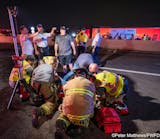Sure enough, the CO detector is actively sounding. The shift lieutenant speaks to Mr. Homeowner and notes that the home, a two-bedroom patio villa, is an entirely electric home. There is no gas heat and no gas appliances. In fact, the home isn?t even piped for gas. The alarm activation is, most likely, the result of a faulty detector.
But, being the ever-vigilant fire officer, the lieutenant orders his crew of three to don SCBA and proceed through the house with the gas detector. Shortly thereafter, one of the firefighters reports a CO reading in the garage of nearly 40 parts per million. Whoa!
Total home ventilation is effected, the attic space is checked and one of the firefighters does a "walk around" of the entire home perimeter. Mr. and Mrs. Homeowner are asked about how they felt, the alarm activation, and any activities in the home that might have set off the detector.
No, they hadn't been burning any candles. No, they hadn't done any late-night charbroiling in the oven. No, they hadn't done anything unusual. In fact, they had been away from the house for several hours, returning at about 10 P.M. Shortly after being dropped off by friends, they went to bed. They were awakened from a sound sleep by the detector.
Come to think of it, yes, they both had a slight headache and had felt a bit queasy when they awoke. But since they had been outside now for nearly 15 minutes, the headache and nausea was almost gone. The lieutenant directed one of the paramedic/firefighters to do medical assessments of both homeowners who were now being considered patients.
Re-evaluation of the garage still showed a significant concentration of CO. But what could be causing the elevated level? The garage contained an automobile, electric golf cart and charger, washer and electric dryer, a few laundry products, and some gardening equipment. The hot water tank and heating/air conditioning system, both totally electric, were also in the garage.
Back to Mr. and Mrs. Homeowner for more Q & A. Was the car used this evening? No, they had gone out with friends. The car hadn?t left the garage in more than 24 hours.
Was the house closed up and the heat on? Yes. The outside temperature was in the mid 50's. The heat had been on all evening.
Was the golf cart used? Mr. Homeowner had played golf earlier in the day and had used the cart. When he returned around 1 P.M. the cart had been parked in it?s usual spot near the heating system and plugged in to the charger. It had been on charge continuously since that time.
Hearing that answer, the firefighter who had conducted the home sweep with the gas detector reported to the lieutenant that the CO reading had been at its highest right near the golf cart and heating system.
Okay, but lead-acid battery charging did not produce CO. So, why the significant carbon monoxide reading? A puzzle to be sure. But since the hour was late, the home was secure, CO levels had dropped to near zero after ventilation, and the residents felt fine (declining any treatment or transport), the call was terminated. The cart was unplugged and the homeowners were instructed to call 911 if there was any further problem.
The call may have been concluded, but the problem wasn?t solved. The incident was recorded and logged with similar situations. In each of those similar situations, CO detectors had been activated in homes with electric golf carts being charged. It was time to do some digging. What was the correlation between golf cart charging and CO detector activation? Why would this be a problem in The Villages?
The second question was the easy one to answer. The Villages, located in the heart of Central Florida, is the fastest growing retirement community in America. The current population is approximately 47,000. By 2012, the population is expected to be 104,000. Fire protection, fire prevention, and emergency medical services are provided by The Villages Public Safety Department, an entity of The Village Center Community Development District, a unit of "special purpose" local government established by Florida State Statute to oversee the growth of The Villages and provide municipal services.
The community presents a lifestyle strongly centered around golf and recreation. As a result, the golf cart is viewed as an essential by many residents and has become the second family car. In some cases it is the only form of transportation. In addition, low speed vehicles (LSVs) are becoming a common sight as gasoline prices shoot upward. Survey data revealed that over 96% of households in The Villages have a golf cart. That?s nearly 22,300 golf carts in private residences. More than 83% (or 18,500) of those are electric.
Lots of golf carts being charged, but why the CO detector activations? Lead acid batteries do not emit carbon monoxide. Lead acid batteries do, however, emit hydrogen, and research gave us both the answer and alerted us to another problem.
The typical CO detector is designed to activate when the unit detects 150 parts per million (ppm) of CO for 30 minutes. That same detector will also activate when exposed to 300 ppm of hydrogen gas for 30 minutes. The amounts of hydrogen gas produced during lead acid battery charging in golf carts far exceed 300 ppm. And, when that charging is done in a closed garage with the golf cart parked next to the heating system, the hydrogen is introduced into the home. Thus the alarm.
So what?s the problem other than nuisance alarms? The dangers of hydrogen became readily apparent as the research continued. Those dangers include asphyxiation, fire, and explosion. Three conditions must exist to cause batteries and charging systems to form an explosive situation. First, there must be an accumulation of hydrogen gases. Second, a failure to detect the hydrogen gas must exist. Third, there must be a source of ignition. Hydrogen gas is odorless, and colorless, and its flammable limits are between 4% and 7%. The level of hydrogen which will produce an oxygen deficient environment is well within the flammable limits. This makes the possibility of fire and explosion very real. In addition, the potential of forming and igniting flammable mixtures is higher because the gas easily migrates through small openings, cracks, and crevices. Ignition sources such as electrical sparks, open flames, and static electricity are readily available and are quite common in the residential as well as commercial environment.
Beyond the obvious danger of fire, explosion and asphyxiation, little data is available indicating the untoward health effects of long-term exposure to the gases given off during the battery charging process. The quantity required to cause death is very substantial. NFPA 704 identifies the health effects of hydrogen as being a 0. In addition, OSHA?s Permissible Exposure Limit (PEL) and Recommended Exposure Level (REL) are not set due to the fact that hydrogen is considered to be relatively safe below the flammable and explosive levels.
Even though hydrogen is viewed as being non-toxic, many occupants in homes responded to by Villages Public Safety Department personnel have complained of headaches, nausea, dyspnea, and vertigo. It is anecdotally believed that this may be caused by hydrogen?s displacement of oxygen in a fairly well-sealed home, and that the lower oxygen concentration may result in patients with the above symptoms.
The Department?s investigation has brought about a new awareness regarding golf cart battery charging and carbon monoxide detector alarms. The Department is putting together a public information program using the community?s newspaper, radio, and television stations to alert golf cart owners to the problem. The ad campaign will stress proper techniques for charging golf cart batteries. Hydrogen gas dissipates at an extremely fast rate and simple ventilation is viewed as the easiest method of controlling potential dangers when charging golf carts. Newer golf carts and chargers allow for automatic shut of the charging system when the cycle is completed. Some older golf cart models and after-market or "adapted" charging systems allow for continuous charging and, as a result, continuous production of hydrogen gas. While we cannot prevent such products from being used, the Department has an obligation to inform the public of the dangers and to take steps to mitigate those dangers.
The Villages Homeowners Association currently conducts golf cart driving safety programs for all residents. We hope to include a segment focused on safe charging of golf carts. The Department is also working with local golf cart dealers to insure that prospective purchasers receive charging instruction brochures.
Lastly, The Villages Department of Public Safety has changed its focus of response to carbon monoxide detector activations from being CO only to potentially being either a CO or hydrogen gas emergency. The Department?s policy of non-emergency response to CO detector activations where residents have left the building has changed to emergency response in every situation due to the significant potential of hydrogen gas explosion and fire.
Emergency services providers have typically looked at the possibility of hydrogen off-gassing from batteries as a minimal problem. In The Villages, we?ve learned otherwise.
Related:





